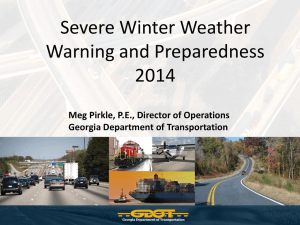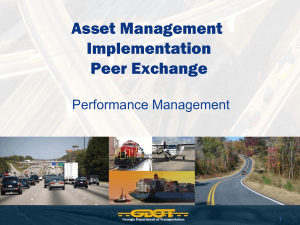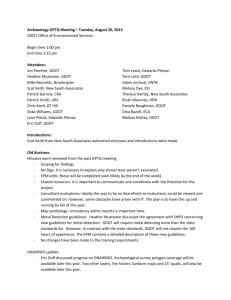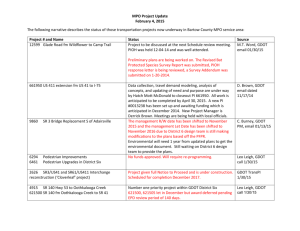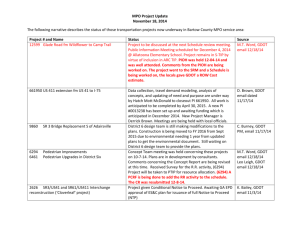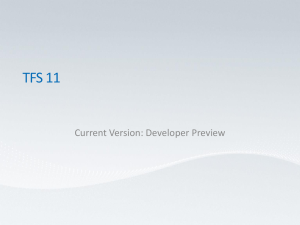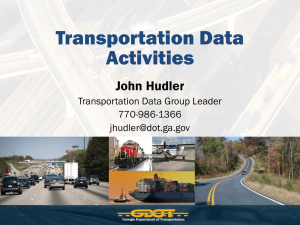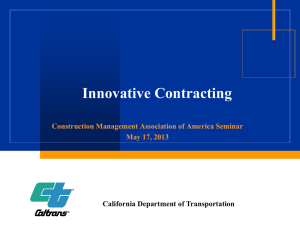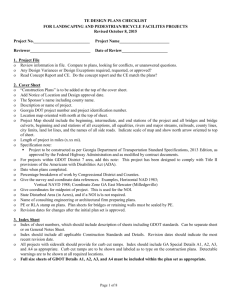Northwest Corridor Project
advertisement
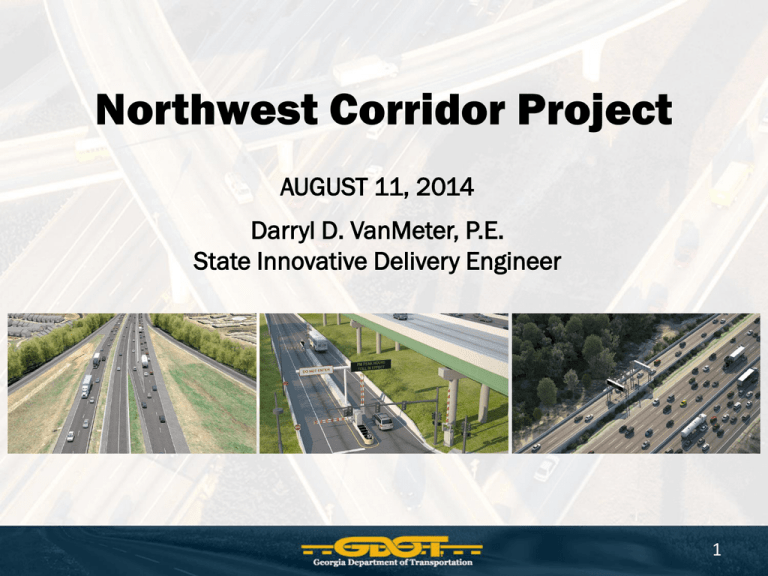
Northwest Corridor Project AUGUST 11, 2014 Darryl D. VanMeter, P.E. State Innovative Delivery Engineer 1 Project Overview 2 Project Overview 3 • Project length of 29.7 miles • Utilizes Public Private Partnership (P3) delivery • Design-Build-Finance (DBF) contract of $598.5M • Begins at Akers Mill Road and terminates at Hickory Grove Road on I-75 and Sixes Road on I-575 • Two (2) reversible barrier separated express lanes along the west side of I-75 from I-285 to I-575/I-75 interchange • One (1) reversible barrier separated express lane in the median on both I-75 and I-575 from the I-75/I-575 interchange • Southbound operations in morning and reverses to northbound operations in evening • Six (6) express lane interchanges on I-75; three (3) slip ramp locations on I-575 • Dynamic tolls manage volumes in express lanes Northwest Corridor Project Rendering Barrier separated express lanes on I-75 south of the I-575 and I-75 interchange 4 Northwest Corridor Project Rendering Barrier gate to enter the Northwest Corridor (NWC) express lanes at Roswell Road 5 Northwest Corridor Project Rendering Northbound slip ramp to enter NWC express lanes 6 Project Benefits • Increased travel options between general purpose and express lanes • Reliable trip times - travel time savings to range from 5.4 to 43.5 minutes, depending on the trip segment and travel direction* • Supports transit service and expansion - transit buses and registered vanpools travel free in the express lanes allowing customers to enjoy the benefits of the express lanes without paying anything beyond the normal transit fare • Supports economic growth by improving access to jobs and attracting new businesses to the region and state * Compared to the No-Build Alternative for 2018 7 Project Status • Private sector partner, also known as Developer, is Northwest Express Roadbuilders (NWER) a joint venture of Archer Western and Hubbard Construction • Project contract with NWER was executed in November 2013 • Design and pre-construction activities underway • Construction expected to begin in summer/fall of 2014 • Project anticipated to open to traffic in summer of 2018 8 Innovative Project Delivery Delivery Options Considered • Public-Financed Design-Bid-Build • Public-Financed Design-Build • Public Private Partnership (P3) Design-Build-Finance (DBF) • P3 Design-Build-Operate-Maintain • P3 Design-Build-Finance-Operate-Maintain 9 Innovative Project Delivery Evaluation Factors • Project cost • Open to traffic • Number of contracts • Price and date certainty of delivery • Potential benefits from private section innovation • Transportation Infrastructure Finance and Innovation Act (TIFIA) credit worthiness • Lifecycle optimization • Private sector term of commitment • Risk allocation to State and Developer • Toll rate control after open to traffic 10 Innovative Project Delivery P3 Design-Build-Finance Selected • Provided shortest time for FHWA environmental approval • Included single contract approach o Avoided coordination risk on GDOT o Maximized innovation o Least cost for overall project management and overhead • Allowed for design-construction innovation and cost savings via implementation of Alternative Technical Concepts (ATCs) • Maximize cost and risk sharing • State maintains control to set toll rate • Developer financing – Allows flexibility in GDOT program finances and delay debt issuance 11 Innovative Project Delivery • First P3 DBF project for GDOT • Sophisticated procurement required technical, legal, and financial expertise in P3 • Enhanced collaboration with industry to ensure procurement transparency and contract clarity o Proposers reviewed draft DBF documents o Extensive one-on-one meetings with each proposer • Procurement goals o Keep construction cost low by inviting innovations o Select the “right” team o Let procurement work for GDOT 12 Innovative Project Delivery • Technical Advisor – Magnitude of project and innovation placed additional challenges on overall decision making requiring collaboration of multiple GDOT Divisions with Technical Advisor to obtain technical recommendations and develop technical contract documents • Legal Advisor – Typically provided internally, however development of new DBF contract and extent of potential risk required outside experience from a firm with previous P3 experience • Financial Advisor – GDOT’s first privately funded project prompted retaining of a financial firm with expertise in P3 13 Project Procurement • Alternative Technical Concept (ATC) process – Confidential process that allowed for innovations and project savings (ATCs are proposer requested deviations from contract requirements) • Developer financing at 10% of design-build-finance contract cost • Design-build approach reduced utility relocation costs • GDOT initiated ROW activities during procurement phase to accelerate start of construction • First use of a web-based project management system – Design submittal review, contract change request, monthly invoice review, noncompliance management, construction document review, etc. • Use of TIFIA Loan • Best value selection – Based on a combination of the price and evaluation criteria • Payment for Work Product 14 Project Procurement Alternative Technical Concepts (ATCs) • Developed State’s first web-based ATC process • Three teams submitted 146 ATCs during process leading up to final proposal submission • Process included incentives for revenue generation and enhanced operation since long-term maintenance of the Northwest Corridor project was under State control • Total estimated savings from ATC process reduced the project cost by an estimate of $60 million • Further reductions were realized through negotiation of unsuccessful proposers’ ATCs into final contract with NWER • GDOT shared schedule risk to further enhance innovations without penalizing Developer 15 Project Procurement Payment for Work Product • Non-selected proposers (2) received a payment of $1.5M each for their ATCs – Proposers’ choice • Encouraged competition by generating market interest • Encouraged proposers to expend the time, money, and resources to provide creative and innovative solutions • Provided proposers compensation in exchange for innovative ideas (ATCs) included in their proposals • Demonstrated State’s commitment to the project 16 Design-Build Phase • Considered a “Major” Project by Federal Highway Administration (FHWA) – Projects with Federal financial assistance with an estimated total cost of $500M or more • Required to satisfy FHWA Major Project requirements – Annual Financial Plan and Project Management Plan • GDOT and State Road and Tollway Authority (SRTA) share project delivery responsibilities 17 Design-Build Phase Design Overview • Typical GDOT project provides all design reviews internally with no consultant assistance • GDOT retained a Submittal Review Consultant who is providing subject matter experts for review of design submittals in all disciplines of design • Review times specified by contract • Submittal process conducted via a web-based project management program to provide accountability and decrease review times by prescribing exact review period for each step of the review process • Coordination and communication between design-build team and Submittal Review Consultant SMEs to minimized “surprises” for both sides 18 Design-Build Phase Construction Overview • Typical GDOT day to day construction management provided by GDOT Division of Construction via either internal staff or consultants know as construction engineering and inspection (CEI) • NWC GDOT Project Manager responsible for day to day management during construction • Design-build team required by contract to retain its own CEI services – First ever in GDOT history • Design-build team CEI performs quality control and quality assurance activities including materials testing and inspection • Owner’s Construction Engineering and Inspection (OCEI) Consultant responsible for construction quality oversight – Quality assurance to ensure design-build team CEI is performing to contract requirements • GDOT Division of Construction provides limited construction oversight responsibilities known as independent assurance • FHWA approval required for project Quality Assurance Plan 19 Project Management Structure GDOT • Procurement • Project Management (Design-Build Phase) • Long Term RoadwayRelated Operations and Maintenance (O&M) and Renewal and Replacement (R&R) Costs • Financial Backstop of Tolling O&M and R&R Costs 20 • Intergovernmental Agreements • Memorandum of Understanding (“MOU”) • Estate for Years (Ground Lease) for Life of the Project • Design-BuildFinance Agreement • TIFIA Application SRTA • Toll Rate Management • Toll Collection and Enforcement • Customer Service Center Operations • Toll Revenue Bonds • TIFIA Borrower Project Financial SOURCES OF FUNDS 21 AMOUNT GDOT Transportation Improvement Program $ 265,879,855 Motor Fuel $ 232,938,325 Private Sector Financing / Developer Financing $ 59,853,386 TIFIA Loan $ 275,000,000 TOTAL SOURCES OF FUNDS $ 833,671,566 Project Financial USE OF FUNDS Design-Build-Finance Costs $ Preliminary Engineering $ Right of Way $ Prior Preliminary Engineer Costs $ GDOT Agency Costs $ Project Contingencies $ TOTAL PROJECT COSTS $ 22 AMOUNT 598,533,817 35,000,000 26,000,000 37,033,872 113,976,612 23,127,265 833,671,566 Project Financial • DBF Contract with Developer for an amount of $598,533,817 for design and construction of project • Developer provided financing is $59,853,386 (10% of DBF Contract) • Repayment of 50% to Developer begins upon Substantial Completion • Final repayment of 50% to Developer is anticipated upon project Final Acceptance • Provides incentive for Developer to complete all punch list items 23 Project Financial Developer Financing • Developer provided basis of financial contribution timing and amount with proposal • 10% of Developer financing made on monthly basis – Included as part of monthly payment requests • Amount of monthly Developer financing update at beginning of every fiscal year • Developer financing required to be fully funded no later than one year (12 months) prior to Substantial Completion 24 Project Financial Monthly Payment Requests • Monthly payments to Developer based on progress during designbuild phase • Total payment requests for each fiscal year cannot exceed maximum available public fund – No monthly maximum established • Payment requests are reviewed and verified for completion of work • Amount of monthly Developer financing included on payment requests also verified • Monthly progress payments managed by GDOT and SRTA • Looking for compliance with DBF contract invoice by invoice 25 Conclusion • The Northwest Corridor project is vital to the State of Georgia because it will help reduce congestion, provide more reliable travel times, and help improve air quality in a heavily travelled region • Northwest corridor project will continue the vibrant economic development in the area and will enhance the quality of life for residents of Cobb County and students of Kennesaw State University • Largest toll project in State’s history lead to unique challenges • Model for future large managed lane project • Emphasis on innovation • Approximately 10 years to obtain environmental approval and 4 ½ years for design and construction of project • Overall project implementation period of 15 years – Challenges resulting from changes in State leadership 26 Questions 27 Questions & Answers Contact: 28 Darryl D. VanMeter, P.E. State Innovative Delivery Engineer Georgia Department of Transportation One Georgia Center 600 West Peachtree Street Atlanta, Georgia 30308 Telephone: (404) 631-1703 Email: dvanmeter@dot.ga.gov

